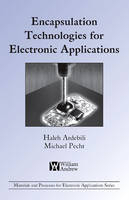
Encapsulation Technologies for Electronic Applications
William Andrew Publishing (Verlag)
978-0-8155-1576-0 (ISBN)
- Titel erscheint in neuer Auflage
- Artikel merken
Electronics are used in a wide range of applications including computing, communication, biomedical, automotive, military and aerospace. They must operate in varying temperature and humidity environments including indoor controlled conditions and outdoor climate changes. Moisture, ionic contamination, heat, radiation and mechanical stresses are all highly detrimental to electronic devices and can lead to device failures. Therefore, it is essential that the electronic devices be packaged for protection from their intended environments, as well as to provide handling, assembly, electrical and thermal considerations.
Currently, more than 99% of microelectronic devices are plastic encapsulated. Improvements in encapsulant materials, and cost incentives have stretched the application boundaries for plastic electronic packages. Many electronic applications that traditionally used hermetic packages such as military are now using commercial-off-the-shelf (COTS) plastic packages. Plastic encapsulation has the advantages of low cost, smaller form factors, and improved manufacturability.
With recent trends in environmental awareness, new environmentally friendly or ' green' encapsulant materials (i.e. without brominated additives) have emerged. Plastic packages are also being considered for use in extreme high and low temperature electronics. 3-D packaging and wafer-level-packaging (WLP) require unique encapsulation techniques. Encapsulant materials are also being developed for micro-electro-mechanical systems (MEMS), bio-MEMS, bio-electronics, and organic light-emitting diodes (O-LEDs).
This book offers a comprehensive discussion of encapsulants in electronic applications. The main emphasis is on the encapsulation of microelectronic devices; however, the encapsulation of connectors and transformers is also addressed. This book discusses 2-D and 3-D packaging and encapsulation, encapsulation materials including environmentally friendly 'green' encapsulants, and the properties and characterization of encapsulants. Furthermore, this book provides an extensive discussion on defects and failures related to encapsulation, how to analyze such defects and failures, and how to apply quality assurance and qualification process for encapsulated packages. This book also provides information on the trends and challenges of encapsulation and microelectronic packages including application of nanotechnology.
Dr. Haleh Ardebili has a BS honors degree in Engineering Science and Mechanics from Pennsylvania State University at University Park, MS degree in Mechanical Engineering from Johns Hopkins University and PhD degree in Mechanical Engineering from University of Maryland at College Park. She has three years of industry experience as research scientist at General Electric Global Research Center at Niskayuna, New York. She is a recipient of GE Invention Fulcrum of Progress Award. She has several years of experience teaching engineering courses at University of Houston. In Sep 2010, she joined as Assistant Professor in the Mechanical Engineering Department at University of Houston. Her research work is mainly focused on nanomaterials for Energy Storage and Electronics. He is the founder and director of CALCE (Center for Advanced Life Cycle Engineering) at the University of Maryland, which is funded by over 150 of the world’s leading electronics companies at more than US$6M/year. He is a Professional Engineer, an IEEE Fellow, an ASME Fellow, an SAE Fellow, and an IMAPS Fellow. He is currently serving as editor-in-chief of Circuit World. He served as editor-in-chief of IEEE Access for 6 years, as editor-in-chief of IEEE Transactions on Reliability for 9 years, and as editor-in-chief of Microelectronics Reliability for 16 years. He has also served on three U.S. National Academy of Science studies, two U.S. Congressional investigations in automotive safety, and as an expert to the U.S. FDA. He is also a Chair Professor. He consults for 22 major international electronics companies, providing expertise in strategic planning, design, test, prognostics, IP and risk assessment of electronic products and systems.
1. Introduction 2. Plastic Encapsulant Materials 3. Encapsulation Process Technology 4. Characterization of Encapsulant Properties 5. Encapsulation Defects and Failures 6. Defect and Failure Analysis Techniques for Encapsulated Microelectronics 7. Qualification and Quality Assurance 8. Trends and Challenges
| Erscheint lt. Verlag | 22.7.2009 |
|---|---|
| Reihe/Serie | Materials and Processes for Electronic Applications |
| Verlagsort | Norwich |
| Sprache | englisch |
| Maße | 152 x 229 mm |
| Gewicht | 930 g |
| Themenwelt | Technik ► Elektrotechnik / Energietechnik |
| ISBN-10 | 0-8155-1576-6 / 0815515766 |
| ISBN-13 | 978-0-8155-1576-0 / 9780815515760 |
| Zustand | Neuware |
| Haben Sie eine Frage zum Produkt? |
aus dem Bereich


